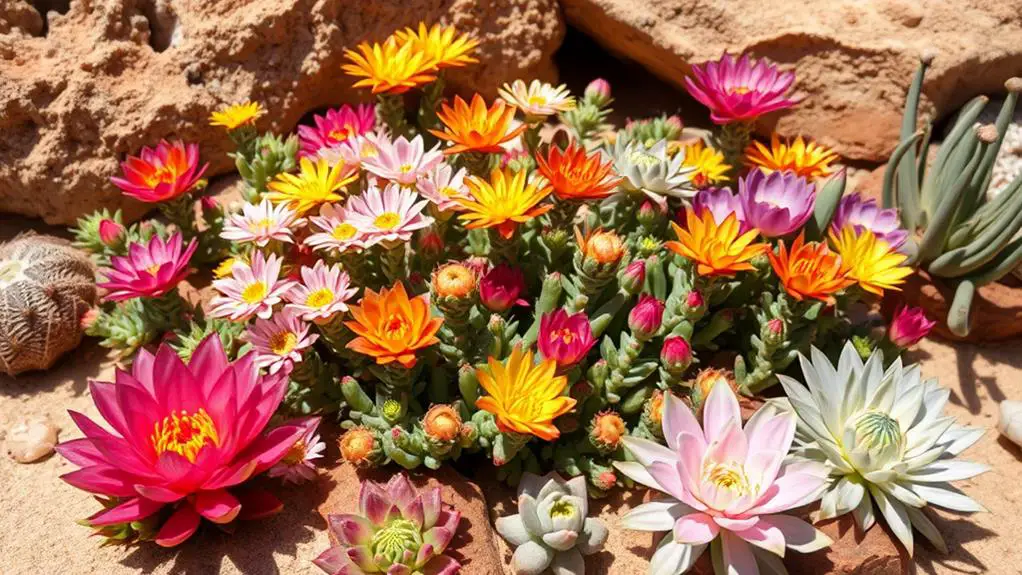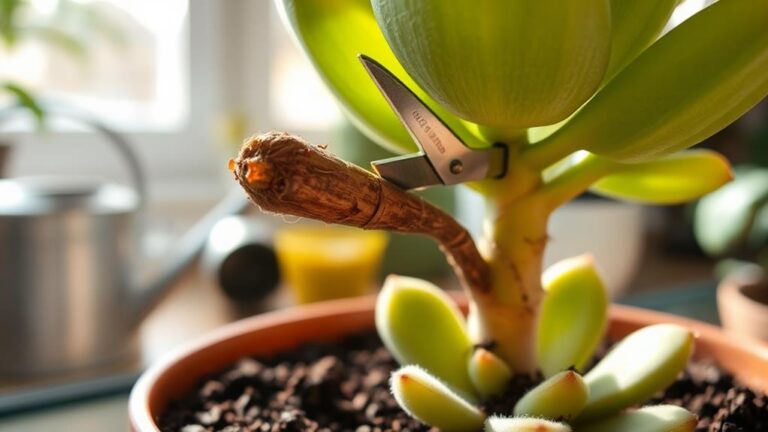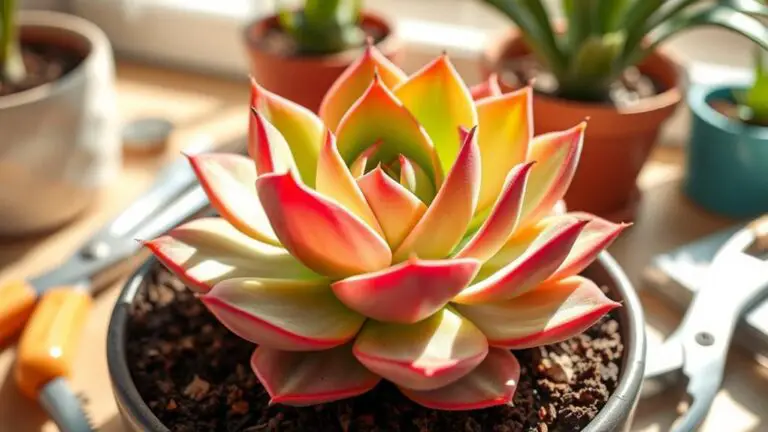Succulent Flowers 101 – A Beginners Guide to Blooming Beauties
You're probably familiar with succulents' sleek, sculptural forms, but did you know they can also produce stunning, delicate flowers? In this guide, you'll explore how environmental factors like light and temperature influence their blooming processes. You'll uncover the differences between polycarpic and monocarpic succulents, and understand how their unique pollinator attraction strategies set them apart from cacti. Curious about how to nurture these plants for vibrant growth and prolific blooms? Let's immerse ourselves in care tips and maintenance strategies that will elevate your succulent game and transform your garden into a blossoming haven.
Flowering Processes
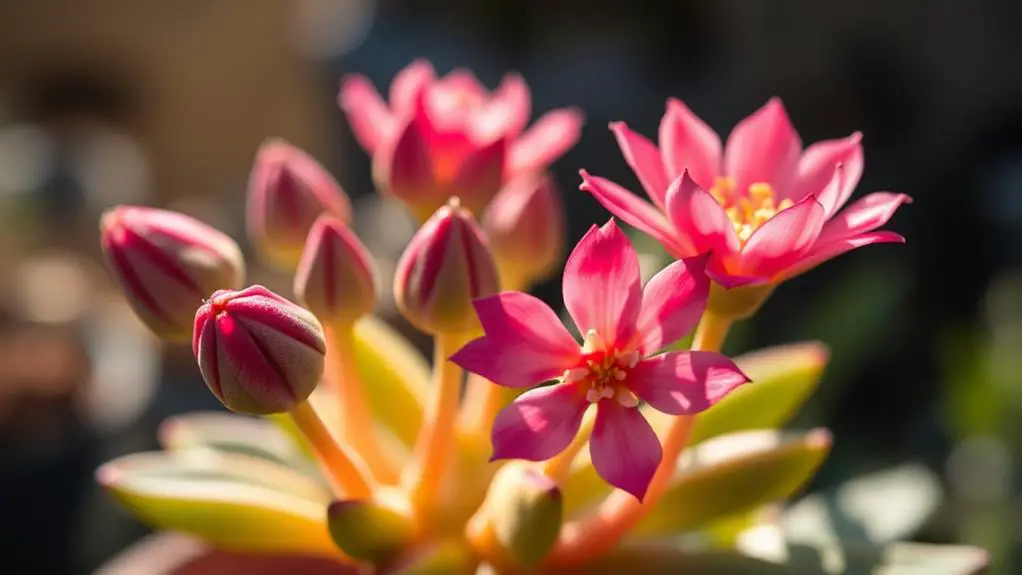
Understanding the flowering processes of succulents can greatly enhance your ability to care for these unique plants. Succulent plants thrive when environmental factors like light intensity, temperature, and humidity are just right. These conditions trigger the production of flowering hormones from florigen genes, leading to blooms.
An important part of succulent care involves knowing that succulents go through a dormancy period. During this phase, they pause their growth and flowering. Recognizing when your plant is dormant helps you adjust your care routine, like reducing watering.
Photoperiodism, or how succulents respond to changes in day length, is another crucial aspect. As days get longer or shorter, succulents detect this shift and begin developing floral buds. This means you should monitor light exposure closely to encourage blooming.
It's also helpful to know the difference between polycarpic and monocarpic succulents. Polycarpic succulents, such as Echeveria and Aloe, can bloom multiple times, while monocarpic succulents like Agave flower only once before dying.
Types of Flowering Succulents
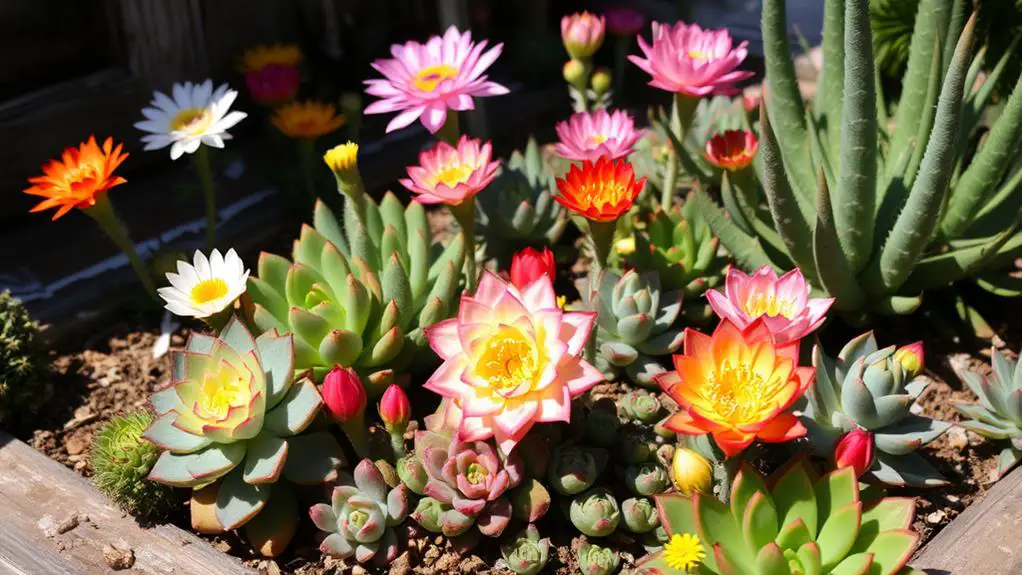
There are two main types of flowering succulents you should know about: polycarpic and monocarpic.
Polycarpic succulents, like Echeveria and Aloe, bloom multiple times throughout their lifespan. This means they can grow and produce flowers year after year.
On the other hand, monocarpic succulents, such as Agave and Sempervivum, flower only once before they die. However, before they die, they usually produce offsets, or "pups," which can grow into new plants.
Understanding these types of flowers is vital for proper care. Polycarpic succulents need consistent care to keep blooming, while monocarpic ones require a bit more attention as they near their flowering stage.
Knowing when and how your succulents bloom helps you decide when to prune and how to allocate their energy during the growing season.
Environmental factors like light intensity, temperature, and humidity also play an important role in their flowering.
Succulent flowers, with their fleshy petals, come in various colors and structures, attracting different pollinators.
With this knowledge, you'll be better equipped to care for your succulents, ensuring they thrive and continue to be beautiful additions to your garden.
Cacti vs. Succulent Flowers
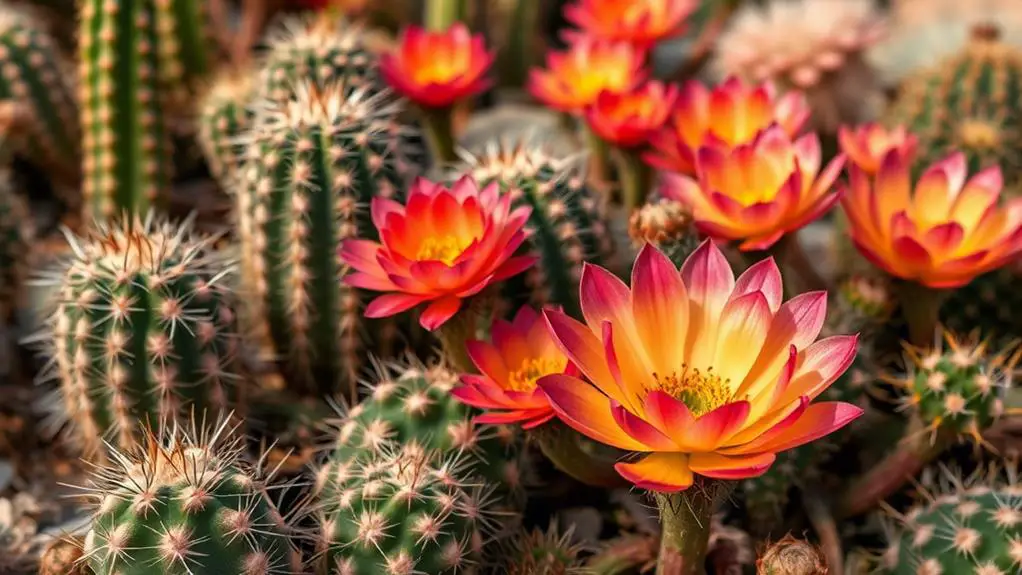
When comparing cacti and succulent flowers, you'll notice their unique differences.
Cacti have large, vibrant blooms that open at night to attract pollinators like moths, while succulent flowers are smaller, fleshier, and attract bees and butterflies during the day.
These adaptations, including their distinct colors and structures, help them thrive in their specific environments.
Flower Morphology Differences
Exploring the differences in flower morphology between cacti and succulents reveals fascinating adaptations to their arid environments. Succulent flowers typically feature fleshy petals that are soft and delicate, designed to attract pollinators like bees and butterflies with their vibrant colors. In contrast, cactus flowers are often more robust and have spiny structures, helping them survive harsh conditions. They produce fewer but larger blooms, making a striking visual impact.
Succulent flowers also tend to produce multiple blooms on a single stalk, creating a lush appearance. This can draw in more daytime pollinators. On the other hand, cacti focus on fewer, more intense flowers, often blooming at night to attract nocturnal pollinators through strong scents.
Here's a quick comparison table to help you understand these differences:
| Feature | Succulent Flowers | Cactus Flowers |
|---|---|---|
| Petal Texture | Soft and fleshy | Spiny and robust |
| Bloom Quantity | Multiple on a single stalk | Fewer but larger |
| Pollinator Attraction | Diurnal pollinators (bees, butterflies) | Nocturnal pollinators (strong scents) |
Both types have evolved unique structures to thrive in their specific habitats. Understanding these differences can help you better care for and appreciate these amazing plants. Happy gardening!
Pollinator Attraction Strategies
Understanding the pollinator attraction strategies of cacti and succulent flowers reveals their ingenious adaptations for thriving in arid environments.
You'll find that succulent flowers often lure diurnal pollinators like bees and butterflies during the day. They use vibrant colors and sweet scents to draw these helpful insects in.
On the other hand, cacti tend to attract nocturnal pollinators such as moths. They rely on strong fragrances released at night to guide these nighttime visitors.
Cacti flowers are typically larger and more visually striking. Their intense hues make them noticeable from a distance, which is a clever way to attract pollinators in vast deserts.
Succulent flowers, however, often produce multiple smaller blooms on a single stalk. This means they can stay in bloom longer, giving them more chances to attract various pollinators throughout the day.
The unique morphology of succulent flowers, with their fleshy petals, contrasts with cacti flowers that might've spines or bracts. This difference influences how pollinators interact with them.
Both cacti and succulents time their flowering to match seasonal changes, ensuring their pollinators are active and ready to help them reproduce.
Coloration and UV Adaptation
Delving into the coloration and UV adaptation of cacti and succulent flowers, you'll find fascinating differences shaped by their environments.
Succulent flowers, with their fleshy petals, are softer in texture and often attract diurnal pollinators. They come in a wide range of colors and shapes, making your garden visually diverse and vibrant. These flowers adapt to varying light intensities and temperatures, which influence their growth and blooming cycles.
Cacti flowers, on the other hand, are known for their spiny morphology, providing extra protection against herbivores. They exhibit more intense hues, a trait that helps attract nocturnal pollinators. The bright colors of cactus flowers are enhanced by UV exposure from sunlight, making them stand out even more in arid landscapes.
While both types of flowers have adapted to survive in harsh environments, their reproductive strategies differ.
Succulent flowers often produce multiple blooms on a single stalk, offering a burst of color and life. In contrast, many cacti feature singular, larger blooms that are equally stunning.
Care and Maintenance
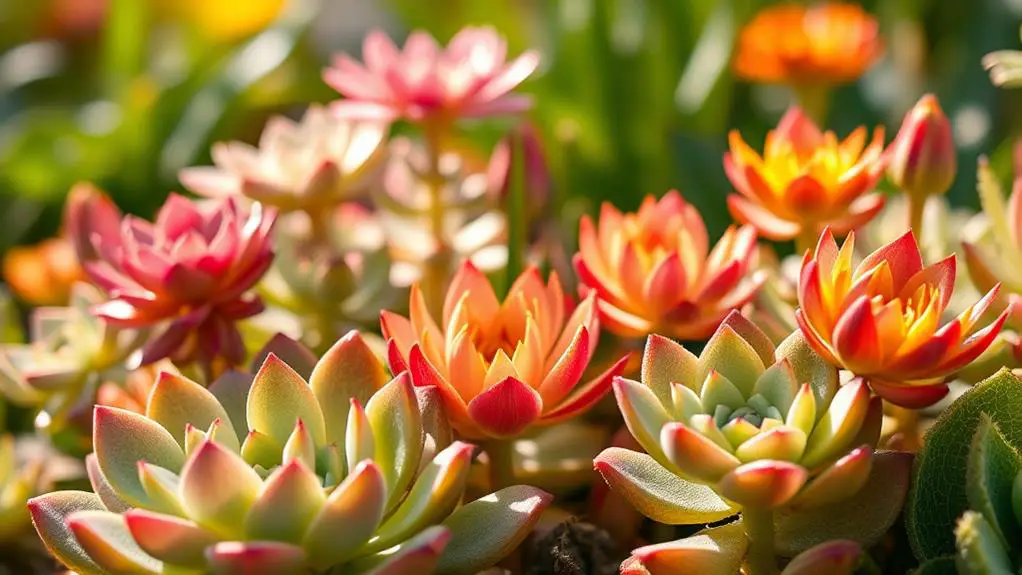
When caring for succulents, paying attention to their unique needs guarantees they thrive and remain healthy.
Proper care and maintenance start with using good soil. Succulents need well-draining soil to prevent root rot. Planting them in pots with drainage holes is vital to manage moisture effectively.
During springtime, adjust your watering schedule and fertilize to support their growth. Keep an eye out for pests like mealybugs and spider mites. Regularly inspect your plants and treat any infestations with neem oil or insecticidal soap promptly.
When it comes to flowering, you might be tempted to leave the blooms, but cutting them off can redirect energy to growth, making your plant fuller and bushier. For younger or newly propagated succulents, removing flowers is especially important to help them conserve energy for root and foliage development.
Here are three important tips to keep your succulents happy:
- Use good soil: Confirm it's well-draining and use pots with drainage holes.
- Adjust care in spring: Modify watering and fertilizing routines.
- Monitor for pests: Regular inspections and prompt treatments are vital.
Gifting and Subscriptions

Succulents make amazing gifts for any occasion, symbolizing resilience and love, and are especially popular on Mother's Day.
You can take it a step further with monthly subscription boxes, where recipients get 1 to 4 locally grown plants each month.
With over 300 varieties available online, you can easily customize these gifts to match anyone's taste.
Thoughtful Succulent Gifts
Looking for a meaningful gift that balances beauty and resilience? Succulents bloom into thoughtful succulent gifts, perfect for any occasion.
These little plants symbolize resilience and love, making them a heartfelt choice. With over 300 varieties available online, you'll find the perfect match for your loved one, and each plant is locally grown in California to guarantee quality and freshness.
Here are three reasons why succulents make the best gifts:
- Personal Touch: You can customize your succulent gifts to reflect the recipient's personality, adding a unique and personal touch.
- Low Maintenance: Succulents require minimal care, making them ideal for both novice and experienced gardeners. Your gift will continue to thrive with just a little love.
- Durable Shipping: Hand-packed with care, these plants are designed to withstand shipping, ensuring they arrive in perfect condition.
Monthly Plant Subscriptions
Gift-giving becomes even more delightful with monthly plant subscriptions. Imagine receiving a curated selection of easy-to-grow succulents right at your doorstep, allowing you to explore over 300 varieties without leaving your home. These subscriptions are perfect for occasions like Mother's Day, symbolizing resilience and love.
Monthly plant subscriptions typically offer flexible plans, ranging from 1 to 4 plants per month. Whether you're gifting or building your collection, there's a plan that fits your needs. Each plant is hand-packed with care, ensuring they arrive in perfect condition, ready to thrive.
| Subscription Plan | Number of Plants |
|---|---|
| Basic | 1 |
| Standard | 2 |
| Premium | 3 |
| Deluxe | 4 |
| Custom | Varies |
Many services source their plants locally from California, assuring quality and health upon arrival. This local growth means the plants are acclimated to diverse environments, making them robust and easy to care for.
Monthly plant subscriptions not only bring beauty into your home but also make the gift-giving process seamless. Each delivery is a delightful surprise, offering a chance to discover new succulent varieties. So, whether you're a seasoned gardener or a beginner, these subscriptions make it easy to enjoy and share the blooming beauty of succulents.
Purchasing Support

When you're ready to add some succulent beauty to your home, purchasing support is essential for a smooth and secure transaction. With over 300 varieties of succulents available online, choosing the right new plants can be exciting but also overwhelming.
Thankfully, secure online checkout processes guarantee your transactions are safe when buying from reputable vendors.
Purchasing support is available to help you every step of the way. A dedicated customer support team can assist with any questions or concerns from Monday through Friday. You can easily reach out via email or phone for personalized help, and you can also find updates and tips on their social media platforms.
To make your succulent purchasing experience even better, consider these benefits:
- Peace of Mind: Secure online checkout processes keep your personal information safe.
- Expert Assistance: Access to a knowledgeable support team guarantees all your questions are answered.
- Convenient Contact Options: Email, phone, and social media give you multiple ways to get help.
Additionally, monthly subscription boxes are a fantastic option if you're looking for a thoughtful gift or want to expand your collection. Each box includes a curated selection of locally grown California succulents, guaranteeing high-quality and variety.
Frequently Asked Questions
How Long Do Succulent Flowers Last?
Succulent flowers last from a few days to several weeks, depending on the species and care. Make sure they receive proper light, temperature, and humidity. Avoid overwatering and drastic temperature changes to maximize their blooming period.
Should You Cut off Succulent Blooms?
You should cut off succulent blooms to redirect energy towards growth, especially for young plants. This helps them become fuller and healthier. However, consider the specific succulent species and your desired look before making a decision.
Do Succulent Flowers Need Sunlight?
Yes, succulent flowers need sunlight to thrive. Aim for about six hours of direct sunlight daily. Monitor each species' needs, as some can prefer partial shade. Too little light results in leggy growth and fewer blooms.
How Often Should You Water Succulent Flowers?
You should water your succulent flowers infrequently. During the growing season, water every 1-3 weeks, but reduce it to once a month in winter. Always let the soil dry out completely between waterings to prevent overwatering.
Conclusion
You've got all the tools you need to start your journey with blooming succulents. Remember, pay attention to light and temperature, and know the differences between polycarpic and monocarpic plants. With a bit of care and regular maintenance, your succulents will thrive and show off their beautiful flowers. Don't be afraid to experiment and learn as you go. You've got this, and your garden will soon be full of stunning, vibrant blooms!

